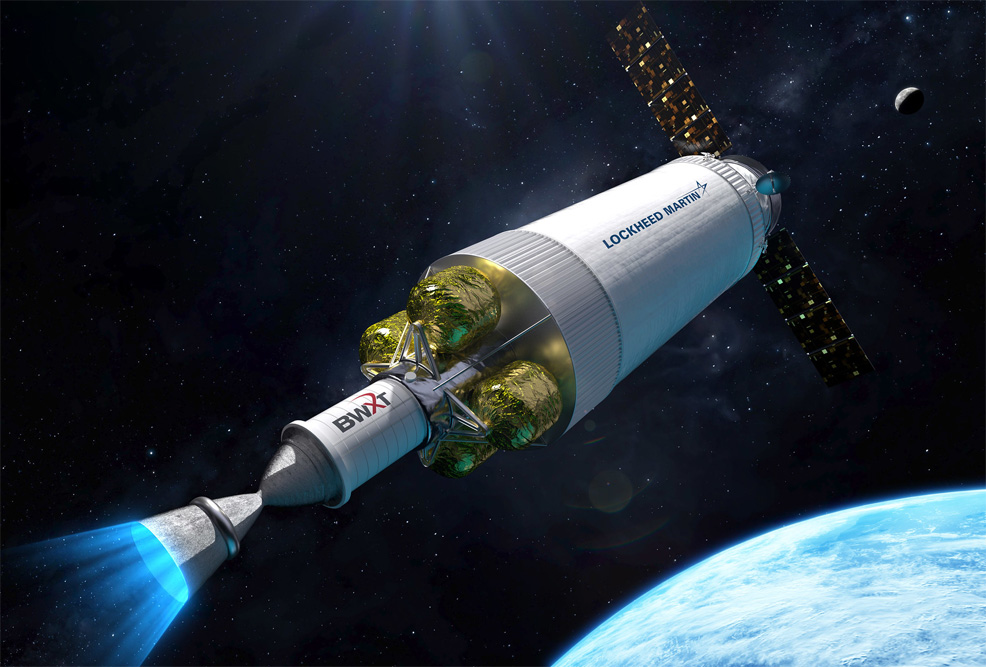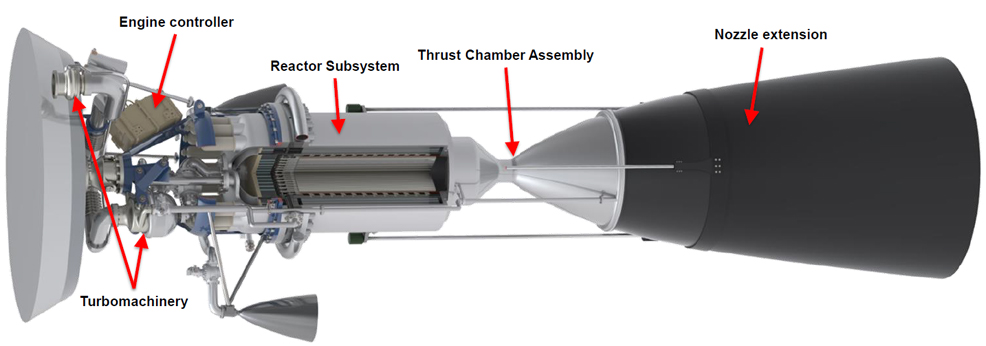
29th July 2023 Nuclear thermal rocket engine to be tested in orbit A collaboration involving NASA, DARPA, Lockheed Martin, and BWX Technologies will attempt the first in-orbit demonstration of a nuclear thermal rocket engine in 2027.
Chemical propulsion engines have long been the standard for spaceflight, but for humans to travel to Mars and beyond, much more powerful and efficient forms of propulsion will be needed. Nuclear thermal propulsion (NTP) engines could offer thrust as high as conventional chemical propulsion but with up to five times higher efficiency, allowing spacecraft to travel faster and farther while significantly reducing propellant needs. They would also enable emergency abort scenarios on journeys to Mars that are not possible with chemical propulsion systems. This week, the Defense Advanced Research Projects Agency (DARPA) awarded contracts to Lockheed Martin and BWX Technologies, to develop and demonstrate a nuclear-powered spacecraft under a project called Demonstration Rocket for Agile Cislunar Operations (DRACO). DARPA itself has also partnered with NASA's Space Technology Mission Directorate on the DRACO project, as both agencies will benefit from this cutting-edge technology. "These more powerful and efficient nuclear thermal propulsion systems can provide faster transit times between destinations. Reducing transit time is vital for human missions to Mars to limit a crew's exposure to radiation," said Kirk Shireman, vice president of Lunar Exploration Campaigns at Lockheed Martin Space. "This is a prime technology that can be used to transport humans and materials to the Moon. A safe, reusable nuclear tug spacecraft would revolutionise cislunar operations. With more speed, agility and manoeuvrability, nuclear thermal propulsion also has many national security applications for cislunar space." Fission, the same process used for nuclear power, is the splitting of atoms. It creates extreme heat, which can turn rocket propellant such as hydrogen from a liquid to a gas phase. In a nuclear thermal rocket, that gaseous propellant is accelerated out of a converging/diverging nozzle in the exact same way as a conventional chemical rocket engine. The high performance of a nuclear thermal rocket is enabled by the reactor passing its heat along to its rocket propellant. The solid core temperatures in the DRACO engine could reach 2,760°C (5,000°F), requiring the use of advanced materials.
Lockheed Martin and BWX Technologies will develop the nuclear reactor's final design, manufacture its hardware and fuel, assemble the components, and deliver the fuelled reactor as a complete subsystem for integration into the rocket. The project is using high-assay low-enriched uranium (HALEU) fuel, made possible via National Security Presidential Memorandum 20 (NSPM-20), which updated U.S. policy for the launch of space-based nuclear power and propulsion. As an additional safety measure, DARPA will engineer the system so that the engine's fission reactor will stay turned off until it reaches its designated orbit. The U.S. Space Force will provide the launch vehicle that carries the DRACO into space. "In the past several years, BWX has been maturing its nuclear thermal propulsion fuel and design, and we are excited to further expand into space with our ability to deliver nuclear products and capabilities to the U.S. Government, " said Joe Miller, President of BWX's Advanced Technologies unit. "We look forward to building the reactor and manufacturing the fuel at our Lynchburg, Virginia, facilities." If all goes according to plan, the spacecraft will launch in 2027. Once it has reached an appropriate location above low earth orbit, the reactor will emerge from "cold" status and be powered on. Following this prototype demonstration, nuclear thermal propulsion systems could then start to be incorporated in a new generation of faster, more efficient rockets. Journeys to Mars could be achieved in a fraction of the current six to nine months. Flexible mission profiles might also become possible, without needing to rely on specific launch windows when Earth and Mars are properly aligned.
Comments »
If you enjoyed this article, please consider sharing it:
|








